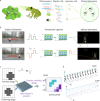In-memory ferroelectric differentiator
- PMID: 40155395
- PMCID: PMC11953435
- DOI: 10.1038/s41467-025-58359-4
In-memory ferroelectric differentiator
Abstract
Differential calculus is the cornerstone of many disciplines, spanning the breadth of modern mathematics, physics, computer science, and engineering. Its applications are fundamental to theoretical progress and practical solutions. However, the current state of digital differential technology often requires complex implementations, which struggle to meet the extensive demands of the ubiquitous edge computing in the intelligence age. To face these challenges, we propose an in-memory differential computation that capitalizes on the dynamic behavior of ferroelectric domain reversal to efficiently extract information differences. This strategy produces differential information directly within the memory itself, which considerably reduces the volume of data transmission and operational energy consumption. We successfully illustrate the effectiveness of this technique in a variety of tasks, including derivative function solving, the moving object extraction and image discrepancy identification, using an in-memory differentiator constructed with a crossbar array of 1600-unit ferroelectric polymer capacitors. Our research offers an efficient hardware analogue differential computing, which is crucial for accelerating mathematical processing and real-time visual feedback systems.
© 2025. The Author(s).
Conflict of interest statement
Competing interests: The authors declare no competing interests.
Figures






References
-
- Swade, D. & Babbage, C. Difference engine: Charles Babbage and the quest to build the First Computer (Viking Penguin, 2001).
-
- Haigh, T. The history of information technology. Annu. Rev. Inf. Sci. Technol.45, 431–487 (2011).
-
- Zangeneh-Nejad, F., Sounas, D. L., Alù, A. & Fleury, R. Analogue computing with metamaterials. Nat. Rev. Mater.6, 207–225 (2021).
-
- Aizawa, K. et al. Computational image sensor for on sensor compression. IEEE Trans. Electron Devices44, 1724–1730 (1997).
LinkOut - more resources
Full Text Sources

